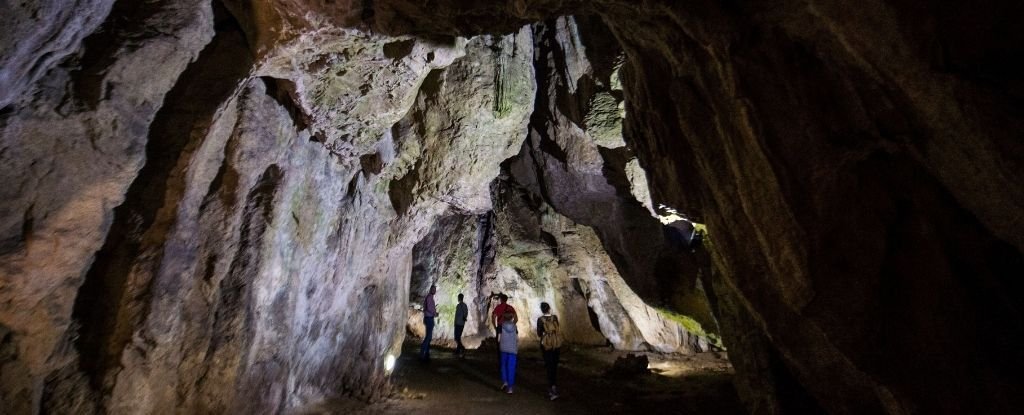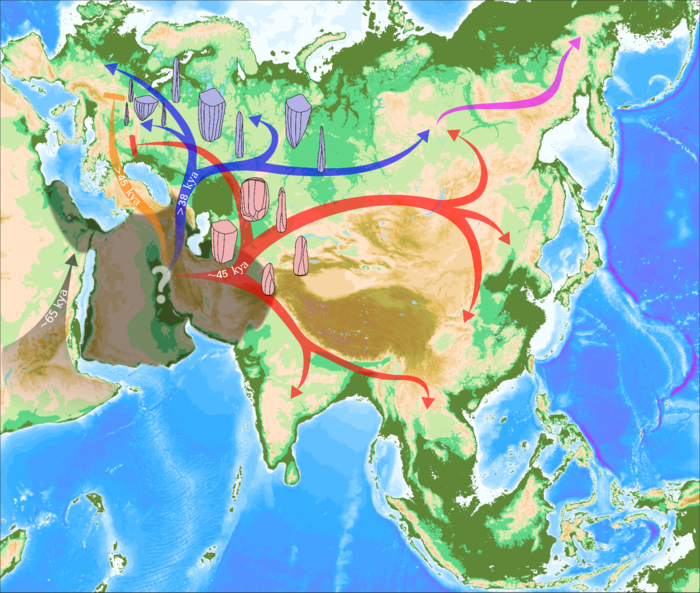
Posted on 04/08/2022 6:59:26 AM PDT by Red Badger

Bacho Kiro Cave. (Nikolay Doychinov/AFP via Getty Images)
Last year, a genetic analysis of bone fragments representing our earliest known presence in Europe raised a few questions over the steps modern humans took to conquer every corner of the modern world.
Whoever the remains belonged to, their family background was more entwined with the East Asian populations of their day than with today's Europeans, hinting at a far more convoluted migration for our species than previously thought.
Now, researchers from the Universities of Padova and Bologna in Italy have proposed what they think might be the simplest explanation for the unexpected kink in the family tree, based on what we can piece together from genetic relationships and subtle shifts in ancient technology around the world.
If we retrace our footsteps from modern times through the Stone Age and beyond, we'll inevitably find a moment when a bunch of Homo sapiens took a pivotal step out of Africa onto what we now think of as Eurasian soil.
Earlier, more distant cousins had ventured out numerous times already, settling for a time before dying out. This time, it would all be different. This migration of modern humans stuck, eventually seeding a cultural revolution that would forever change our planet in just a few short millennia.
While the outcome of this monumental journey is now obvious, the paths taken and countless lost branches can only be pieced together from scant surviving artifacts and a legacy of genetic mingling.
The scattering of human bones and stone implements sifted from the sediment of Bacho Kiro Cave in central Bulgaria is just the kind of evidence archaeologists dream of. Uncovered in 2015, they have since been dated to around 45,000 years, officially making them the oldest Upper Paleolithic hominin bones ever found in Europe.
By taking archaeological records into account, we can tell they had descended from a larger community on a 15,000-year-long hiatus in their travels east. If we knew little else about them, we might conclude this people represent some kind of stepping stone between a future in Asia and a past set in Europe – a central hub on Africa's doorstep from which we expanded and settled ever further abroad.
The genetic evidence preserved in three of those bodies, however, doesn't match up quite so neatly with this simple scenario.
Last year, research led by the Max Planck Institute for Evolutionary Anthropology in Germany concluded the individuals were "more closely related to present-day and ancient populations in East Asia and the Americas than to later west Eurasian populations."
Finding closer familial ties with modern and ancient Asian populations than with modern European people introduces some challenging questions regarding the way this ancient hub of humanity might have branched into the east and west.
What's more, a generous dose of Neanderthal blood had recently been introduced into their family tree, further muddying the waters on how our ancestors might have moved and interacted.
According to the authors of this newest study, one possibility considers the migration of humanity a stutter rather than a surge.
"Then, around 45 thousand years ago, a new expansion emanated from the hub and colonized a wide area spanning from Europe to East Asia and Oceania and is associated with a mode of producing stone tools known as Initial Upper Paleolithic," says University of Padua molecular anthropologist, Leonardo Vallini.

MapOfHumanHubExpansion
(Leonardo Vallini, Giulia Marciani)
Above: An unknown hub in the west, from which humans expanded in waves of migration.
Those who branched into Asia thrived, traces of their bloodlines persisting to this day. But something happened in the west, something which saw a temporary end to the human experiment in Europe.
A second study conducted last year on female remains found in the Czechia provides a clue. While carbon dating is yet to confirm an age for her death, changes in her genes hinted at a date even further back than 45,000 years.
More importantly, the Paleolithic woman's ancestry wasn't closely related to either modern Europeans or Asians. Whatever happened to her and her kin, their story wasn't an enduring one.
"It is curious to note that, around the same time, also the last Neanderthals went extinct," says Giulia Marciani, an archaeologist from the University of Bologna.
It would have taken a fresh wave of human emigration from this central hub some 7,000 years later to repopulate the west and seed lineages that would go on to produce the rich array of cultures we see today.
Just where this temporary hub of humanity might be found and what prompted its populations to set off again and again is a matter for future archaeologists to figure out.
If we've learned nothing else, it's clear we shouldn't make too many assumptions when it comes to the story of how modern humanity made its way around the world.
This research was published in Genome Biology and Evolution.
I think Africa was chosen only because they could find bones in the arid climate.
Cain. Jealous, violent, disobedient, and all around A-hole.I love finding solid Biblical interpretation!
A population hub out of Africa explains East Asian lineages in Europe 45,000 years ago
https://www.eurekalert.org/news-releases/948948
Neolithic made us taller and more intelligent but more prone to heart disease
How modern European populations have evolved over the past 50,000 years
Date: April 6, 2022
Source: Radboud University Medical Center
https://www.sciencedaily.com/releases/2022/04/220406101723.htm
Thanks Red Badger.
The Neandertal Enigma"Frayer's own reading of the record reveals a number of overlooked traits that clearly and specifically link the Neandertals to the Cro-Magnons. One such trait is the shape of the opening of the nerve canal in the lower jaw, a spot where dentists often give a pain-blocking injection. In many Neandertal, the upper portion of the opening is covered by a broad bony ridge, a curious feature also carried by a significant number of Cro-Magnons. But none of the alleged 'ancestors of us all' fossils from Africa have it, and it is extremely rare in modern people outside Europe." [pp 126-127]
by James Shreeve
in local libraries
KEYWORDS: neandertal; neandertals; neanderthal; neanderthals
Looks like all the homosexuals migrated to Siberia.
My guess is that early humans were continually exploring for food, especially in directions where there weren’t already competing (and territory-defending) humans.
Consider an early tribe. They settle in an area where there is good hunting, and plentiful food allows them to have many surviving children. The kids grow up, and groups set out to explore what’s available a few miles away. Over a generation, people can spread a hundred miles. Over several generations, a thousand miles.
Perhaps the disappearance of types of human remains for long periods of time or forever were based on a new mostly fatal illness. If they were following large herds, an animal virus could have killed off their prey, or there could have been a jump from animal to human, like swine flu has done.
I wish I had a good sample of my late husband’s DNA. He had Scotish ancestry from his father, 1/16th Cree Indian from his mother, bright red hair and pink skin; very hairy chest and one shoulder, receeding chin which looked much better with a beard, extreme mesomorph body, light blue eyes, intense emotions especially anger; died of Alzheirmers age 75.
I have a theory that people from primative, isolated, tribal societies may be more likely to die of Alzheimers. My husband started wandering about 2 years before he died. I had to watch him like a hawk and quickly give him a snack because he tried to go out if he was hungry. This was after he had few skills to take care of himself but was still mobile. I would have to urge him back to bed at 4 in the morning when he wanted to go outside and walk in the city. As he became more physically compromised this behavior subsided. My theory is this behavior had survival value because in hunger times a person with this gene would get up at night (perhaps to pee) and wander off looking for food and freeze to death, or in a tropical or temperate clime be killed by preditors. Thus their food would be available for their offspring, In urban settings such wanderers would be brought back to their families.
I compared figures for Alzheimers in urban Africn countries and US Afro-Americans. The figure was much higher in the US, Now this could be bacause of diet, but I suspect many of the slaves brought here were captured from isolated villages, rather than from the major African cities. Anyway I think this is an interesting hypothesis that could use some research.
I guess we can backtrack from my 2 sons. Also my own DNA might be interesting. Half my origin is East Prussian/Polish from 1800s. There was Asian conquest blood left behind, especially in the upper classes like my grandmother. I have shoveled upper lateral incisors, which is possibly a Neanderthal trait. Also, my molars are very large. My other grandfather was Welsh, and his wife had early US American, mostly British origins. Anyone know which is the best ancestry company for Neanderthal analysis or facts?
No
But, I've always found this article interesting.
Ancestry.com does NOT give Neanderthal dna. 23and me does.
That’s sumthin I had never heard of before. Sounds like it’s a good time to go into archaeology, with so many mysteries to solve.
Maybe he has cousins on both sides?
From the article, “”more closely related to present-day and ancient populations in East Asia and the Americas than to later west Eurasian populations.”
***Yet another bump for the Solutrean Hypothesis.
https://en.wikipedia.org/wiki/Solutrean_hypothesis
The beginning of agriculture and wheat (grass seed) eating.......carbs create cholesterol.................
The Soul Train Hypothesis?...................
That’s where Malibu Barbie hangs out.
Longer lifespans made heart disease more common.
Disclaimer: Opinions posted on Free Republic are those of the individual posters and do not necessarily represent the opinion of Free Republic or its management. All materials posted herein are protected by copyright law and the exemption for fair use of copyrighted works.